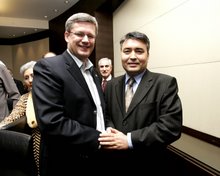THE PEOPLE'S REPUBLIC OF CHINA AT SIXTY: THE FEAR OF SELF-EXAMINATION
Huffington Post
Henryk Szadziewski
Manager, Uyghur Human Rights Project
Posted: October 1, 2009 10:48 AM
October 1, 2009 marks sixty years since Mao Zedong proclaimed the establishment of the People's Republic of China (PRC) from the Gate of Heavenly Peace in Beijing. China's capital has been readied for a parade of 200,000 people to honor the achievements of six decades of Chinese Communist Party (CCP) administration. It is a time for Party officials the length and breadth of the country to reflect on sixty years of rule which has brought China to the brink of superpower status.
October 1 also marks the 54th anniversary of the founding of the Xinjiang Uyghur Autonomous Region, an area also known as East Turkestan. The capital of the region, Urumchi, experienced a wave of unrest this summer and has been tense in the build up to October 1. In preparation, an estimated 130,000 additional troops have been deployed to the region to ensure that new unrest does not break out at this sensitive time. Despite the long-standing problems besetting the region, Party officials are unlikely to reflect on why six decades of CCP rule has driven such a profound wedge between the region's Uyghurs and Han Chinese.
An ethnically charged incident in Shaoguan, Guangdong on June 26, 2009 has been widely portrayed as the trigger for the recent unrest in Urumchi, which began on July 5, 2009. During the incident Han Chinese attacked Uyghur workers at a toy factory after the spread of unsubstantiated rumors concerning a rape by six Uyghur men of two Han Chinese women. The seriousness of the Shaoguan incident has been down played by Chinese criminal and judicial authorities. This has been illustrated by the Chinese official media's line that only two Uyghurs were killed in Shaoguan and by the indictments related to the case; but, as the Guardian newspaper has reported, eyewitnesses tell a different story. A Han Chinese man involved in the Shaoguan killings stated in the Guardian report that he personally "helped to kill seven or eight Uighurs, battering them until they stopped screaming."
Given the lack of clarity over the Shaoguan incident and the Chinese authorities' feet dragging on legal procedures, it should not have been surprising that Uyghurs in Urumchi took it upon themselves to organize a peaceful demonstration to spur Chinese officials into action. On July 5, 2009, the day of the Uyghur demonstration, and on the days that followed, a number of innocent Uyghurs and Han Chinese were killed as unrest in Urumchi spiraled out of control. The unrest not only revealed the profound schism between Uyghur and Han Chinese communities, but also exposed the disenfranchisement Uyghurs feel after sixty years of CCP administration.
From the purges of East Turkestan nationalists in the Anti-Rightist Campaign of the late fifties, to the starvation, exile and cultural destruction of the Great Leap Forward (1958-1962) and the Cultural Revolution (1966-1976), Uyghurs, along with millions of other victims in the PRC, were persecuted by the CCP. In addition, in the first three decades of CCP rule Uyghurs were the target of campaigns specifically aimed to dilute their distinct identity as a people. In the early sixties, the CCP administration instigated a forced resettlement policy with the aims of dispersing concentrations of Uyghurs and of isolating Uyghurs from their communities.
The current situation facing Uyghurs can hardly be said to be an improvement, and intensifying Uyghur repression has correlated with the growth of China's economic and political power on the world stage. China's interest in the region stems from the valuable natural resources, namely oil, on which it sits and from the strategic importance attached to the region's proximity to Russia, South Asia and Central Asia. The Chinese government's thirst for energy to fuel economic growth in eastern China and its increasing dominance in global affairs has put the long neglected region onto the CCP's radar and turned the Uyghur presence in the region into a question of assimilation into the Chinese fold.
The Chinese government has employed long-term and short-term measures to achieve the assimilation of the land and the people. These measures have impacted every area of Uyghur society, including its politics, economics, and culture. The long term measures include the forced transfer of young Uyghur women to eastern China while encouraging mass Han Chinese migration into the region, the demolition of Uyghur cultural heritage in Kashgar, a monolingual language-planning policy, discriminatory hiring practices, and curbs on freedom of religion. The short-term measures, such as torture and execution on political charges, ensure that a climate of fear pervades among Uyghurs so that the gradual erosion of the Uyghur identity can carry on unabated. All these measures spell out a clear, but stark outcome for Uyghurs: eventual disappearance as a distinct people.
Since 1949, repressive Chinese government policies in the region have only served to divide Uyghurs from Han Chinese and have pushed the prospect of a genuine solution to Uyghur grievances further away. As CCP officials in Beijing and Urumchi celebrate on October 1 by witnessing a parade of China's military and economic success, they would be wise to consider those citizens who have been the losers in the sixty years of CCP administration. A future with peace, security and prosperity for the Uyghur people, and indeed all people in the region, lies in a bold move from the Chinese government. Just as Deng Xiaoping made a bold move to take China into an era of economic reform; Hu Jintao will have to make a bold move, by talking with dissenters, such as World Uyghur Congress President, Rebiya Kadeer, to take China into an era of meaningful political reform.
Friday, October 02, 2009
Subscribe to:
Post Comments (Atom)






No comments:
Post a Comment